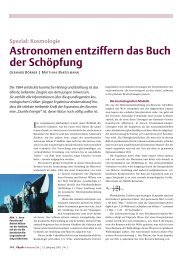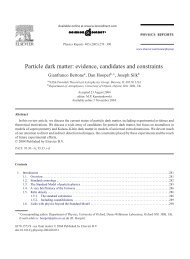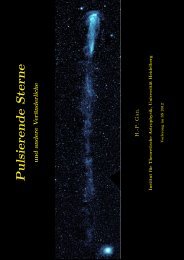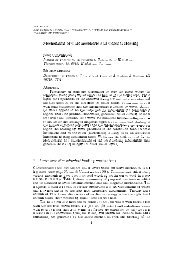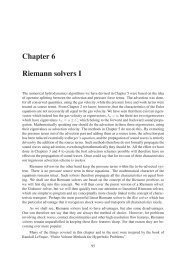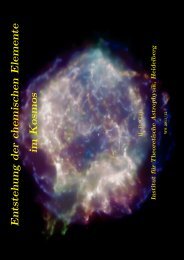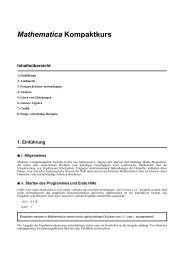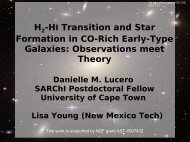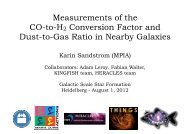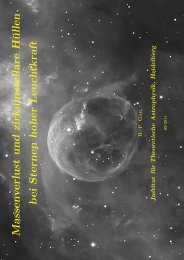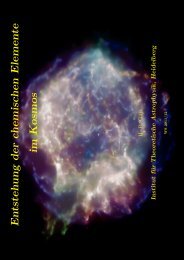The Shapes of the HI Velocity Proï¬les of the THINGS Galaxies
The Shapes of the HI Velocity Proï¬les of the THINGS Galaxies
The Shapes of the HI Velocity Proï¬les of the THINGS Galaxies
You also want an ePaper? Increase the reach of your titles
YUMPU automatically turns print PDFs into web optimized ePapers that Google loves.
<strong>The</strong> <strong>Shapes</strong> <strong>of</strong> <strong>the</strong> <strong>HI</strong><br />
<strong>Velocity</strong> Pr<strong>of</strong>iles from<br />
T<strong>HI</strong>NGS<br />
Erwin de Blok<br />
(ASTRON/UCT)<br />
Roger Ianjamasimanana<br />
Bradley Frank<br />
Moses Mogotsi<br />
Anahi Caldu-Primo<br />
T<strong>HI</strong>NGS and HERACLES<br />
teams
T<strong>HI</strong>NGS<br />
•<br />
•<br />
•<br />
•<br />
•<br />
<strong>The</strong> <strong>HI</strong> Nearby Galaxy Survey - Walter et al (2008)<br />
VLA B,C,D array <strong>of</strong> 34 nearby Sa-Irr galaxies<br />
distance 3-15 Mpc<br />
~6” spatial (100-500 pc), 2-5 km/s velocity resolution<br />
overlap with SINGS (Spitzer infrared) and GALEX NGS (UV)
T<strong>HI</strong>NGS<br />
•<br />
•<br />
•<br />
•<br />
•<br />
<strong>The</strong> <strong>HI</strong> Nearby Galaxy Survey - Walter et al (2008)<br />
VLA B,C,D array <strong>of</strong> 34 nearby Sa-Irr galaxies<br />
distance 3-15 Mpc<br />
~6” spatial (100-500 pc), 2-5 km/s velocity resolution<br />
overlap with SINGS (Spitzer infrared) and GALEX NGS (UV)<br />
HERACLES<br />
•<br />
•<br />
HERACLES - Leroy et al. (2009)<br />
HEterodyne Receiver Array CO Line Extragalactic<br />
Survey<br />
•<br />
•<br />
HERA multipixel receiver on IRAM 30m telescope<br />
Maps CO J=2→1 <strong>of</strong> entire <strong>HI</strong> disk <strong>of</strong> 18 T<strong>HI</strong>NGS galaxies<br />
(+o<strong>the</strong>rs)<br />
•<br />
13” spatial and 2.6 km/s velocity resolution (~ T<strong>HI</strong>NGS)
Outline<br />
• Stacking <strong>of</strong> T<strong>HI</strong>NGS <strong>HI</strong> pr<strong>of</strong>iles<br />
•<br />
•<br />
•<br />
Broad and Narrow <strong>HI</strong> components<br />
Comparison with CO from HERACLES<br />
Narrow-component <strong>HI</strong> and SF
NGC 2841<br />
T<strong>HI</strong>NGS<br />
NGC 3621<br />
NGC 7331<br />
NGC 4826<br />
(M64)<br />
<strong>The</strong> <strong>HI</strong> Nearby<br />
Galaxy Survey<br />
NGC 6946<br />
NGC 3198<br />
NGC 3184<br />
NGC 925<br />
NGC 3351<br />
(M95)<br />
NGC 5194<br />
(M51)<br />
NGC 3521<br />
NGC 2366<br />
NGC 4214<br />
NGC 2976<br />
DDO 53<br />
Our Galaxy<br />
<strong>HI</strong> stars<br />
NGC 1569<br />
M81dwB<br />
M81dwA<br />
NGC 5236<br />
(M83)<br />
IC 2574<br />
NGC 4449<br />
NGC 3627<br />
(M66)<br />
Holmberg II<br />
NGC 7793<br />
DDO 154<br />
NGC 4736<br />
(M94)<br />
NGC 3077<br />
Holmberg I<br />
NGC 5055<br />
NGC 2903<br />
10 kpc<br />
NGC 628<br />
(M74)<br />
NGC 5457<br />
(M101)<br />
NGC 3031<br />
(M81)<br />
NGC 2403<br />
Data: Walter et al 2008<br />
Milky Way <strong>HI</strong> map: Oort et al (1958)<br />
Milky Way art: NASA/JPL, R. Hurt (SSC)
NGC 2841<br />
T<strong>HI</strong>NGS<br />
NGC 7331<br />
observed by<br />
HERACLES<br />
NGC 6946<br />
NGC 3198<br />
NGC 3184<br />
NGC 925<br />
NGC 3351<br />
(M95)<br />
NGC 5194<br />
(M51)<br />
NGC 3521<br />
NGC 4214<br />
NGC 2976<br />
DDO 53<br />
NGC 2366<br />
M81dwB<br />
M81dwA<br />
IC 2574<br />
NGC 4449<br />
Holmberg II<br />
DDO 154<br />
NGC 4736<br />
(M94)<br />
NGC 3077<br />
Holmberg I<br />
NGC 5055<br />
NGC 2903<br />
NGC 628<br />
(M74)<br />
NGC 2403<br />
10 kpc<br />
Data: Walter et al 2008<br />
Milky Way <strong>HI</strong> map: Oort et al (1958)<br />
Milky Way art: NASA/JPL, R. Hurt (SSC)
NGC 2841<br />
HERACLES<br />
NGC 7331<br />
NGC 6946<br />
NGC 3198<br />
NGC 3184<br />
NGC 925<br />
NGC 3351<br />
(M95)<br />
NGC 5194<br />
(M51)<br />
NGC 3521<br />
NGC 4214<br />
NGC 2976<br />
DDO 53<br />
NGC 2366<br />
M81dwB<br />
IC 2574<br />
Holmberg II<br />
DDO 154<br />
NGC 4736<br />
(M94)<br />
NGC 3077<br />
Holmberg I<br />
NGC 5055<br />
NGC 2903<br />
10 kpc<br />
NGC 628<br />
(M74)<br />
NGC 2403
Needed for star formation<br />
• “Cold” gas a necessary ingredient for star<br />
formation<br />
• Neutral → cold neutral → molecular → SF<br />
• Investigate cold neutral component: mass,<br />
distribution and velocity dispersion
Phases <strong>of</strong> <strong>the</strong> Neutral ISM<br />
• Broad: Warm: T ~ 104 K<br />
• Narrow: Cold: T ~ few 100 K<br />
• but dispersions higher -<br />
turbulence et al<br />
Warm<br />
Cold<br />
de Blok & Walter 2006a<br />
also Young & Lo 1997, Braun 1997, etc<br />
de Blok & Walter 2006
Phases <strong>of</strong> <strong>the</strong> Neutral ISM<br />
• Broad: Warm: T ~ 104 K<br />
• Narrow: Cold: T ~ few 100 K<br />
• but dispersions higher -<br />
turbulence et al<br />
Warm<br />
Cold<br />
de Blok & Walter 2006a<br />
also Young & Lo 1997, Braun 1997, etc<br />
de Blok & Walter 2006
Phases <strong>of</strong> <strong>the</strong> Neutral ISM<br />
• Broad: Warm: T ~ 104 K<br />
• Narrow: Cold: T ~ few 100 K<br />
• but dispersions higher -<br />
turbulence et al<br />
Warm<br />
Cold<br />
de Blok & Walter 2006a<br />
also Young & Lo 1997, Braun 1997, etc<br />
de Blok & Walter 2006
NGC 2841<br />
T<strong>HI</strong>NGS<br />
NGC 3621<br />
NGC 7331<br />
NGC 4826<br />
(M64)<br />
<strong>The</strong> <strong>HI</strong> Nearby<br />
Galaxy Survey<br />
NGC 6946<br />
NGC 3198<br />
NGC 3184<br />
NGC 925<br />
NGC 3351<br />
(M95)<br />
NGC 5194<br />
(M51)<br />
NGC 3521<br />
NGC 2366<br />
NGC 4214<br />
NGC 2976<br />
DDO 53<br />
Our Galaxy<br />
<strong>HI</strong> stars<br />
NGC 1569<br />
M81dwB<br />
M81dwA<br />
NGC 5236<br />
(M83)<br />
IC 2574<br />
NGC 4449<br />
NGC 3627<br />
(M66)<br />
Holmberg II<br />
NGC 7793<br />
DDO 154<br />
NGC 4736<br />
(M94)<br />
NGC 3077<br />
Holmberg I<br />
NGC 5055<br />
NGC 2903<br />
10 kpc<br />
NGC 628<br />
(M74)<br />
NGC 5457<br />
(M101)<br />
NGC 3031<br />
(M81)<br />
NGC 2403<br />
Data: Walter et al 2008<br />
Milky Way <strong>HI</strong> map: Oort et al (1958)<br />
Milky Way art: NASA/JPL, R. Hurt (SSC)
Stacking <strong>the</strong> pr<strong>of</strong>iles<br />
NGC 2366<br />
Ianjamasimanana et al. 2012<br />
(accepted AJ: arXiv:1207.5041)<br />
Shift<br />
Sum<br />
“Super pr<strong>of</strong>ile”
F<br />
0<br />
F<br />
0<br />
F<br />
0<br />
F<br />
0<br />
4<br />
Flux [Jy beam 1 ]<br />
37.4 37.4<br />
Flux [Jy beam 1 1 ] ]<br />
1.6 1.6 4.2<br />
Super Pr<strong>of</strong>iles<br />
146.6 146.6<br />
31.6<br />
200<br />
31.6<br />
150200100150 50100 0 50 50 0 10050 150 100 200 150<br />
<strong>Velocity</strong> <strong>Velocity</strong> [km s 1 ][km s 1 ]<br />
200<br />
100 100 350<br />
80 300 80<br />
NGC 3351<br />
DDO NGC154<br />
3351<br />
250<br />
60 60<br />
200<br />
40<br />
150 40<br />
20 100 20<br />
0<br />
50<br />
0<br />
0<br />
Flux [Jy beam 1 ]<br />
1 ]<br />
129.7<br />
200129.7<br />
150 200 100 150 50 100 050 500 100 50 150 100<br />
<strong>Velocity</strong> <strong>Velocity</strong> [km s 1 [km ] s 1 ]<br />
200 150 200<br />
100<br />
350 100<br />
300 80 N=279<br />
80<br />
NGC 3351<br />
DDO 154NGC 3351<br />
250<br />
60<br />
200<br />
60<br />
150<br />
40 40<br />
100 20<br />
50<br />
0<br />
0<br />
20.9 8.9<br />
Flux [Jy beam 1 ]<br />
20<br />
0<br />
8.9<br />
Flux [Jy beam 1 ]<br />
1.4 1.4<br />
200 150<br />
3.5<br />
200 80100150 60 50100 40 0 2050 0 10050 20 150 100 40 200 150 60 200 80<br />
<strong>Velocity</strong> <strong>Velocity</strong> [km s 1 ][km s 1 ]<br />
200 200 600<br />
150<br />
100<br />
50<br />
0<br />
Flux [Jy beam 1 ]<br />
150<br />
500<br />
400<br />
100<br />
300<br />
200 50<br />
100<br />
0<br />
0<br />
NGC 3184 NGC 3184 3521<br />
3.1 15.7 3.1<br />
2.9 14.5 2.9<br />
100 100 30050 200 50 0100 0 50 100 50 100 200 100 300<br />
<strong>Velocity</strong> <strong>Velocity</strong> [km s 1 ][km s 1 ]<br />
Flux<br />
Flux [Jy<br />
[Jy<br />
beam<br />
beam 1 ]<br />
15.6 7.0 7.0<br />
200 80 150 60 200 100 40 150 20 50 100 050 20 500 100 40 50 150 60 100 200 80 150 200<br />
<strong>Velocity</strong> <strong>Velocity</strong> [km s 1 [km ] s 1 ]<br />
200 600 200<br />
500<br />
150<br />
400<br />
100 300<br />
200 50<br />
100<br />
0<br />
0<br />
Flux [Jy beam 1 ]<br />
N=1215<br />
150<br />
100<br />
50<br />
0<br />
NGC 3184 3521 NGC 3184<br />
21.3 53.5 21.3<br />
42.7<br />
14.8 14.8<br />
100 300 100 200 50 10050 0 0100 50 20050 100 300 100<br />
<strong>Velocity</strong> <strong>Velocity</strong> [km s 1 [km ]<br />
s 1 ]
Pr<strong>of</strong>iles<br />
28<br />
1G 2G 1G 2G 1G 2G<br />
30<br />
31<br />
Figure 25. Super pr<strong>of</strong>iles <strong>of</strong> <strong>the</strong> T<strong>HI</strong>NGS galaxies. For each galaxy, we show <strong>the</strong> results from <strong>the</strong> single (left panel) and double (middle<br />
panel) Gaussian fitting. <strong>The</strong> right panels show a fit with a Lorentzian function. <strong>The</strong> bottom panels <strong>of</strong> each set <strong>of</strong> plots show <strong>the</strong> residuals<br />
from <strong>the</strong> fits. <strong>The</strong> filled circles indicate <strong>the</strong> data. <strong>The</strong> solid black lines represent <strong>the</strong> results from <strong>the</strong> single, <strong>the</strong> sum <strong>of</strong> <strong>the</strong> double Gaussian,<br />
and <strong>the</strong> Lorentzian fitting. <strong>The</strong> dotted and <strong>the</strong> dashed lines in <strong>the</strong> middle panel represent <strong>the</strong> narrow and broad components required in<br />
<strong>the</strong> double Gaussian fitting. We plot error bars as 3 error bars, though in most cases <strong>the</strong>y are smaller than <strong>the</strong> symbols plotted.<br />
Figure 25. (continued).<br />
Figure 25. (continued).
11<br />
Figure 2. Solid histogram: ratio <strong>of</strong> <strong>the</strong> reduced<br />
2 from <strong>the</strong> triple<br />
and single<br />
Dispersions<br />
Gaussian fits ( 2 3G / 2 1G<br />
). Dotted histogram: ratio <strong>of</strong> <strong>the</strong><br />
reduced 2 from <strong>the</strong> double and single Gaussian fits ( 2 2G / 2 1G ).<br />
Hatched histogram: ratio <strong>of</strong> <strong>the</strong> reduced 2 from <strong>the</strong> triple and<br />
double Gaussian fits ( 2 3G / 2 2G ).<br />
2G narrow<br />
1G<br />
2G broad<br />
betw<br />
and<br />
is ⇠<br />
From<br />
inpu<br />
This<br />
cube<br />
clina<br />
disp<br />
due<br />
Fi<br />
pr<strong>of</strong>i<br />
can<br />
<strong>the</strong><br />
com<br />
whe<br />
show<br />
ratio<br />
imp<br />
extr<br />
over<br />
rout<br />
pr<strong>of</strong>i<br />
in th<br />
reso<br />
T<strong>HI</strong><br />
<strong>of</strong> th
False Super Pr<strong>of</strong>iles<br />
• Many ways to get a non-Gaussian super pr<strong>of</strong>ile<br />
• Inclination and resolution effects<br />
• Dominant narrow pr<strong>of</strong>iles<br />
• Thick, lagging component<br />
• Skewed input pr<strong>of</strong>iles<br />
• Inaccurate shuffling<br />
• Bulk motions (galaxy interaction, starburst)<br />
• Tested and under control: Ianjamasimanana et al 2012
False Super Pr<strong>of</strong>iles<br />
Inclination: 63<br />
• Many ways to get a non-Gaussian super pr<strong>of</strong>ile<br />
• Inclination and resolution effects<br />
• Dominant narrow pr<strong>of</strong>iles<br />
Resolution <strong>Velocity</strong> Flux ratio Resolution <strong>Velocity</strong><br />
dispersion<br />
dispersion<br />
1G n b A n /A b 1G<br />
( 00 ) (pc) (km s 1 ) (km s 1 ) (km s 1 ) (pc) (km s 1 )<br />
4 62 8.6 8.5 15.5 83.3 78 8.1<br />
8 124 8.6 8.6 15.4 60.6 155 8.1<br />
11 171 8.6 8.6 15.4 56.6 213 8.1<br />
20 310 8.9 8.8 15.6 23.4 388 8.2<br />
30 465 9.3 9.0 16.1 12.4 582 8.3<br />
40 621 9.8 9.3 16.8 7.9 776 8.4<br />
50 776 10.1 9.6 17.5 5.6 970 8.6<br />
60 931 10.6 9.8 18.1 4.2 1164 8.8<br />
Inclination: 80<br />
4 62 9.4 9.0 16.1 9.0 78 8.1<br />
8 124 9.5 9.1 16.4 7.7 155 8.1<br />
11 171 9.7 9.2 16.6 6.6 213 8.1<br />
20 310 10.4 9.6 17.7 4.0 388 8.2<br />
30 465 11.4 10.0 19.0 2.6 582 8.3<br />
40 621 12.5 10.6 20.5 1.8 776 8.5<br />
50 776 13.6 11.2 21.9 1.4 970 8.7<br />
60 931 14.9 11.8 23.3 1.2 1164 9.0<br />
Note. — 1G : <strong>Velocity</strong> dispersion derived from one-component Gaussian fit. n: <strong>Velocity</strong> dispersion<br />
<strong>of</strong> <strong>the</strong> narrow component. b: <strong>Velocity</strong> dispersion <strong>of</strong> <strong>the</strong> broad component. A n /A b :Ratio<strong>of</strong><strong>the</strong><br />
fluxes or masses associated with <strong>the</strong> narrow and broad components. Here, only <strong>the</strong> single Gaussian<br />
results <strong>of</strong> <strong>the</strong> IC 2574 models are shown (see Section 4.1).<br />
• Thick, lagging component<br />
“NGC 2403” at 63 degrees inclination<br />
“NGC 2403” at 80 degrees inclination<br />
• Skewed input pr<strong>of</strong>iles<br />
• Inaccurate shuffling<br />
• Bulk motions (galaxy interaction, starburst)<br />
• Tested and under control: Ianjamasimanana et al 2012<br />
Figure 5. Observed and simulated super pr<strong>of</strong>iles <strong>of</strong> NGC 2403 derived after smoothing <strong>the</strong> model data cubes to <strong>the</strong> resolution indicated<br />
on <strong>the</strong> plots. <strong>The</strong> left and right panels represent <strong>the</strong> results from <strong>the</strong> model data cubes <strong>of</strong> NGC 2403 with input inclination <strong>of</strong> 63 and 80 ,<br />
respectively. <strong>The</strong> dotted and <strong>the</strong> dashed lines represent <strong>the</strong> narrow and broad components required in <strong>the</strong> double Gaussian fitting. <strong>The</strong><br />
solid lines represent <strong>the</strong> results <strong>of</strong> <strong>the</strong> double Gaussian fitting.
False Super Pr<strong>of</strong>iles<br />
• Many ways to get a non-Gaussian super pr<strong>of</strong>ile<br />
• Inclination and resolution effects<br />
• Dominant narrow pr<strong>of</strong>iles<br />
• Thick, lagging component<br />
• Skewed input pr<strong>of</strong>iles<br />
• Inaccurate shuffling<br />
• Bulk motions (galaxy interaction, starburst)<br />
• Tested and under control: Ianjamasimanana et al 2012<br />
Figure 8. Top panel: comparison <strong>of</strong> super pr<strong>of</strong>ile parameters derived from <strong>the</strong> faint and bright parts <strong>of</strong> galaxie<br />
<strong>of</strong> super pr<strong>of</strong>ile parameters from <strong>the</strong> normalized and <strong>the</strong> original super pr<strong>of</strong>iles. <strong>The</strong> triangle shaped symb
False Super Pr<strong>of</strong>iles<br />
• Define clean sample <strong>of</strong> galaxies not obviously<br />
affected by <strong>the</strong>se systematic effects (also no star burst,<br />
no interaction)<br />
• Example: compare approaching and receding sides
Symmetrical Pr<strong>of</strong>iles<br />
SYSTEMATIC UNCERTAINTIES 71<br />
NGC 925<br />
4214<br />
Text<br />
Text<br />
NGC 3621<br />
NGC Text 3627<br />
Text<br />
Text<br />
NGC 7331<br />
NGC 2403<br />
Ho Text I<br />
Text<br />
NGC 4736<br />
Flux Jy beam 1<br />
Flux Jy beam 1<br />
300<br />
250<br />
200<br />
150<br />
100<br />
50<br />
0<br />
50<br />
100 50 0 50 100<br />
<strong>Velocity</strong> km s 1<br />
200<br />
150<br />
100<br />
50<br />
0<br />
Text<br />
NGC 4449<br />
Text<br />
Text<br />
NGC 7793 IC 2574<br />
NGC Text 5055<br />
NGC<br />
Text<br />
3184<br />
Text<br />
NGC 5236<br />
50<br />
100 50 0 50 100<br />
<strong>Velocity</strong> km s 1<br />
SYSTEMATIC UNCERTAINTIES<br />
50<br />
Flux Jy beam 1<br />
250<br />
200<br />
150<br />
100<br />
50<br />
0<br />
50<br />
100 50 0 50 100<br />
<strong>Velocity</strong> km s 1<br />
200<br />
Text<br />
Figure 4.5: NGC Examples 4826 <strong>of</strong> super pr<strong>of</strong>iles <strong>of</strong> NGC 2366 using LHAP (top left panel), RHAP (top right<br />
panel) and SP (bottom panel)<br />
Flux Jy beam 1<br />
Flux Jy beam 1<br />
200<br />
150<br />
100<br />
0<br />
50<br />
100 50 0 50 100<br />
<strong>Velocity</strong> km s 1<br />
300<br />
150<br />
100<br />
50<br />
0<br />
asym<br />
asym<br />
sym<br />
Flux Jy beam 1<br />
200<br />
150<br />
100<br />
50<br />
0<br />
50<br />
100<br />
Figure 17. Location <strong>of</strong> symmetric and asymmetric pr<strong>of</strong>iles for <strong>the</strong> T<strong>HI</strong>NGS galaxies. Blue pixels represent symmetric pr<strong>of</strong>iles (SP). Green<br />
and red pixels represent left-handed asymmetric pr<strong>of</strong>iles (LHAP) and right-handed asymmetric pr<strong>of</strong>iles (RHAP), respectively. Ellipses<br />
represent <strong>the</strong> optical radius r 25 .<strong>The</strong>smallgreycirclesindicate<strong>the</strong>approachingsides.<br />
|vHer3-vIWM| < 5 km s -1 to identify symmetrical pr<strong>of</strong>iles<br />
50<br />
100 50 0 50 100<br />
<strong>Velocity</strong> km s 1<br />
Figure 4.5: Examples <strong>of</strong> super pr<strong>of</strong>iles <strong>of</strong> NGC 2366 using L<br />
panel) and SP (bottom panel)
<strong>Velocity</strong> Dispersions<br />
Narrow<br />
Narrow component:<br />
6.5 ± 1.5 kms 1<br />
Broad component:<br />
Broad<br />
16.8 ± 4.3 kms 1
But is this relevant for star formation?
Global Properties<br />
24<br />
narrow/broad<br />
dispersion ratio<br />
narrow/broad<br />
flux ratio<br />
●: symm pr<strong>of</strong>s, clean sample<br />
Figure 22. Top panel: velocity dispersion ratio as a function <strong>of</strong> metallicity, (FUV-NUV) colors and Hα luminosities. Bottom pa<br />
o☐: symm. pr<strong>of</strong>s, o<strong>the</strong>r galsratio<br />
<strong>of</strong> <strong>the</strong> narrow metallicity<br />
and broad components as a function <strong>of</strong> metallicity, FUV-NUV (FUV-NUV) colors and Hα luminosities. <strong>The</strong> triangle<br />
represent interacting galaxies (those that are tidally interacting with a nearby companion or are being affected by <strong>the</strong>ir environm<br />
are NGC 3031, NGC 4449, NGC 5194, NGC 5457, NGC 3077). <strong>The</strong> open circle symbols represent galaxies that are disturbed kine
20<br />
σn inside R25 (km s -1 )<br />
n inside r25 [km s 1 ]<br />
An/Ab inside r25<br />
14<br />
12<br />
10<br />
8<br />
6<br />
4<br />
2<br />
2 3 4 5 6 7 8 9<br />
n outside r 25 [km s 1 ]<br />
1.4<br />
narrow<br />
σn outside R25 (km s -1 )<br />
Refining <strong>the</strong> pr<strong>of</strong>iles<br />
4<br />
σb inside R25 (km s -1 )<br />
b inside r25 [km s 1 ]<br />
35<br />
30<br />
25<br />
20<br />
15<br />
10<br />
5<br />
0<br />
4.0<br />
10 15 20 25 30<br />
b outside r 25 [km s 1 ]<br />
1.2<br />
3.5<br />
3.0<br />
1.0<br />
• Do properties change 2.5 as a function <strong>of</strong> local<br />
radialenvironment?<br />
pr<strong>of</strong>iles <strong>of</strong> <strong>the</strong> narrow and broad components can<br />
be explained by <strong>the</strong> fact that <strong>the</strong> CNM and WNM have<br />
0.8<br />
2.0<br />
di erent densities and <strong>the</strong>refore have di erent response<br />
•<br />
to incoming radiation. (discussion still in progress)<br />
0.6<br />
1.5<br />
Create super pr<strong>of</strong>iles using masks<br />
7.2. Does <strong>the</strong> narrow component trace molecular gas?<br />
1.0<br />
0.4<br />
( In progress)<br />
•<br />
0.5<br />
0.2 Example: dispersions and mass ratios inside R 8. CONCLUSION<br />
0.0<br />
25 (high star<br />
0.0<br />
0.5<br />
0.0 0.2 0.4forming) 0.6 0.8 1.0 1.2 and 1.4 outside 0.5R25 0.0 0.5(no 1.0 1.5 or 2.0 2.5 very 3.0 3.5 low 4.0 star formation)<br />
A n /A b outside r 25<br />
Deg. asym. outside r 25 [km s 1 ]<br />
Fig. 19.— Top panel :Comparison<strong>of</strong><strong>the</strong>derivedvelocitydispersionsinsideandoutsider 25 .<strong>The</strong>leftpanelisfor<strong>the</strong>narrowcomponent,<br />
whereas <strong>the</strong> right panel is for <strong>the</strong> broad component. Bottom panel: Comparison <strong>of</strong> <strong>the</strong> mass ratio <strong>of</strong> <strong>the</strong> narrow to that <strong>of</strong> <strong>the</strong> broad<br />
component inside and outside r 25 (left panel). <strong>The</strong> right panel compares <strong>the</strong> degree <strong>of</strong> asymmetry (defined as <strong>the</strong> o set between <strong>the</strong> peak<br />
velocity <strong>of</strong> <strong>the</strong> narrow component and <strong>the</strong> peak velocity <strong>of</strong> <strong>the</strong> broad component) <strong>of</strong> <strong>the</strong> super pr<strong>of</strong>iles inside and outside r 25 . <strong>The</strong> solid<br />
lines are lines <strong>of</strong> equality.<br />
Deg. asym. inside r25 [km s 1 ]<br />
broad<br />
σb outside R25 (km s -1 )<br />
An/Ab inside R25<br />
n inside r25 [k<br />
An/Ab inside r25<br />
8<br />
6<br />
2<br />
2 3 4 5 6 7 8 9<br />
n outside r 25 [km s 1 ]<br />
1.4<br />
1.2<br />
1.0<br />
0.8<br />
0.6<br />
0.4<br />
0.2<br />
mass ratios<br />
0.0<br />
0.0 0.2 0.4 0.6 0.8 1.0 1.2 1.4<br />
A n /A b outside r 25<br />
An/Ab outside R25<br />
Fig. 19.— Top panel :Comparison<strong>of</strong><strong>the</strong>derivedvelocitydisper<br />
whereas <strong>the</strong> right panel is for <strong>the</strong> broad component. Bottom pa<br />
component inside and outside r 25 (left panel). <strong>The</strong> right panel co<br />
velocity <strong>of</strong> <strong>the</strong> narrow component and <strong>the</strong> peak velocity <strong>of</strong> <strong>the</strong> b<br />
lines are lines <strong>of</strong> equality.<br />
Preliminary
Radially<br />
13<br />
Figure 6.<br />
Plot <strong>of</strong> An/Ab ratio as a function <strong>of</strong> Column density.<br />
Preliminary
Radial trends<br />
13<br />
b<br />
n<br />
velocity dispersion<br />
radius [R25]
Trend with column density<br />
Figure 6.<br />
Plot <strong>of</strong> An/Ab ratio as a function <strong>of</strong> Column density.<br />
A n /A b is <strong>the</strong> flux ratio <strong>of</strong> <strong>the</strong> broad and narrow<br />
components
Star formation rates<br />
SUPER PROFILES AND PROPERTIES OF GALAXIES<br />
<strong>The</strong> Star Formation Efficiency in Nearby <strong>Galaxies</strong> 67<br />
Define SFR masks using Leroy et al (2008)<br />
T<strong>HI</strong>NGS star formation rate maps (24μm<br />
Spitzer and GALEX FUX)<br />
N<br />
N<br />
N<br />
9<br />
8<br />
7<br />
6<br />
5<br />
4<br />
3<br />
2<br />
1<br />
0<br />
6<br />
5<br />
4<br />
3<br />
2<br />
1<br />
0<br />
10<br />
8<br />
6<br />
LOW SFR<br />
10 -4 < SFR < 10 -3 M⊙ yr -1 kpc -2<br />
MEDIUM SFR<br />
10 -3 < SFR < 10 -2 M⊙ yr -1 kpc -2<br />
<strong>HI</strong>GH SFR<br />
SFR > 10 -2 M⊙ yr -1 kpc -2<br />
4<br />
2<br />
0<br />
0 10 20 30 40 50 60<br />
n,b [km s 1 ]<br />
Preliminary<br />
Figure 5.5: Histograms <strong>of</strong> <strong>the</strong> velocity dispersion <strong>of</strong> <strong>the</strong> narrow (solid histogr<br />
all pr<strong>of</strong>iles, all galaxies<br />
histograms) components derived in low, medium and high SFR regions. <strong>The</strong> veloci
NGC 2841<br />
HERACLES<br />
NGC 7331<br />
NGC 6946<br />
NGC 3198<br />
NGC 3184<br />
NGC 925<br />
NGC 3351<br />
(M95)<br />
NGC 5194<br />
(M51)<br />
NGC 3521<br />
NGC 4214<br />
NGC 2976<br />
DDO 53<br />
NGC 2366<br />
M81dwB<br />
IC 2574<br />
Holmberg II<br />
DDO 154<br />
NGC 4736<br />
(M94)<br />
NGC 3077<br />
Holmberg I<br />
NGC 5055<br />
NGC 2903<br />
10 kpc<br />
NGC 628<br />
(M74)<br />
NGC 2403
NGC 2403 Example<br />
Bradley S. Frank 1 , W. J. G. de Blok 1,2 ,<br />
<strong>The</strong> HERACLES Team<br />
1 <strong>The</strong> Astrophysics, Cosmology and Gravity Centre (ACGC), <strong>The</strong> University <strong>of</strong> Cape Town, South Africa<br />
2 Ne<strong>the</strong>rlands Institute for Radio Astronomy, ASTRON, Ne<strong>the</strong>rlands<br />
Abstract<br />
<strong>The</strong> HERACLES survey is one <strong>the</strong> largest and most sensitive survey <strong>of</strong> CO in nearby galaxies. We compare <strong>the</strong> kinematics <strong>of</strong> <strong>the</strong> <strong>HI</strong> and <strong>the</strong> CO in <strong>the</strong> T<strong>HI</strong>NGS galaxies.<br />
In this poster we focus on two galaxies, NGC 3198 and NGC 7331. Both are late-type spirals with a central-depression in <strong>the</strong> <strong>HI</strong> emission, which shows high CO<br />
emission in <strong>the</strong> centre. We derive velocity fields and rotation curves for both galaxies, and show that combining <strong>the</strong> CO and <strong>HI</strong> produces a complete rotation curve<br />
for <strong>the</strong> case <strong>of</strong> NGC 7331. We find that, in <strong>the</strong> absence <strong>of</strong> bars, <strong>the</strong> overall dynamics <strong>of</strong> <strong>the</strong> CO to be very similar to that <strong>of</strong> <strong>the</strong> <strong>HI</strong>.<br />
<strong>HI</strong> and CO Intensity Maps for NGC 3198<br />
NGC 3198<br />
SB type galaxy -<br />
CO emission<br />
concentrated in<br />
<strong>the</strong> centre.<br />
<strong>HI</strong> and CO <strong>Velocity</strong> Fields (Hermite) for NGC 3198<br />
T<strong>HI</strong>NGS-<strong>HI</strong><br />
HERACLES-CO<br />
T<strong>HI</strong>NGS-<strong>HI</strong><br />
HERACLES-CO<br />
PV-Diagram for NGC 3198<br />
T<strong>HI</strong>NGS-<strong>HI</strong><br />
HERACLES-CO<br />
Rotation Curves for NGC 3198<br />
NGC 3198 was one <strong>of</strong> <strong>the</strong> first galaxies for which <strong>the</strong> kinematics was derived using a tilted-ring model. Here we use <strong>the</strong> Hermite-polynomial derived velocity-fields<br />
to compute a rotation curve using <strong>the</strong> tilted-ring model. <strong>The</strong> effect <strong>of</strong> <strong>the</strong> streaming-motions due to <strong>the</strong> spiral-arms on <strong>the</strong> rotation curve <strong>of</strong> <strong>the</strong> CO can be seen<br />
at 30” and ~ 85”.<br />
<strong>HI</strong> and CO Intensity Maps for NGC 7331<br />
T<strong>HI</strong>NGS-<strong>HI</strong><br />
HERACLES-CO<br />
NGC 7331<br />
Sb early-type spiral<br />
- Post-starburst<br />
galaxy - Centraldepression<br />
in <strong>HI</strong><br />
emission filled by<br />
CO.<br />
<strong>HI</strong> and CO <strong>Velocity</strong> Fields (Hermite) for NGC 7331<br />
T<strong>HI</strong>NGS-<strong>HI</strong><br />
HERACLES-CO<br />
PV-Diagram for NGC 7331<br />
T<strong>HI</strong>NGS-<strong>HI</strong><br />
HERACLES-CO<br />
Rotation Curves for NGC 7331<br />
poster by Bradley Frank<br />
Intensity map shows that CO fills <strong>the</strong> <strong>HI</strong> “hole”. PV-diagrams shows solid-body like kinematics in centre; velocity fields illustrate <strong>the</strong> overlap between <strong>HI</strong> and CO -<br />
ideal for combining rotation curves. Kinematic parameters converge to model after a few iterations, rotation curve in agreement with von Linden et al. (1996)<br />
References: <strong>The</strong> <strong>HI</strong> Nearby Galaxy Survey, Walter et al. 2008 - HERACLES: <strong>The</strong> HERA CO Line Extragalactic Survey, Leroy et al. 2009 -<br />
T<strong>HI</strong>NGS Rotation Curves and Mass Models, de Blok et al. 2008 - <strong>The</strong> Dynamics <strong>of</strong> <strong>the</strong> Inner Part <strong>of</strong> NGC 7331, von Linden 1996
NGC 2403 Example
NGC2403 VELOCITY FIELDS<br />
T<strong>HI</strong>NGS<br />
HERACLES<br />
Contours:<br />
-40 to 340 km/s in<br />
steps <strong>of</strong> 30 km/s
NGC2403 POSITION VELOCITY<br />
major-axis<br />
minor-axis<br />
- HERACLES<br />
- T<strong>HI</strong>NGS<br />
contours start from +3σ<br />
in steps <strong>of</strong> +3σ
NGC2403 ROTATION CURVES<br />
5kpc
CO Dispersions<br />
poster by Moses Mogotsi
NGC 3184 Example
CO dispersions
<strong>HI</strong>-CO comparisons<br />
σ <strong>HI</strong> = (1.5 ± 0.2) σ CO<br />
σ <strong>HI</strong> - σ CO =(7.2 ± 1.3) km/s<br />
Note σ CO and σ <strong>HI</strong>,narrow similar
Stacking <strong>the</strong> CO<br />
Anahi Caldu-Primo and Fabian Walter<br />
<strong>HI</strong><br />
CO<br />
<strong>HI</strong> CO<br />
Stack&<strong>HI</strong>,&CO&spectra&in&bins&<strong>of</strong>&radius,&SFR,&total&gas<br />
<strong>Velocity</strong>&Dispersion<br />
as&func>on&<strong>of</strong>&radius&
Stacking <strong>the</strong> CO<br />
Anahi Caldu-Primo and Fabian Walter<br />
Ra>o&<strong>of</strong>&<strong>HI</strong>/CO&<strong>Velocity</strong>&Dispersion&…<br />
...&binned&by&Radius<br />
&&&&Ra>o&<strong>of</strong>&<strong>HI</strong>/CO&<strong>Velocity</strong>&Dispersion&for&all&<strong>Galaxies</strong><br />
…&binned&by&SFR<br />
…&binned&by&Total&Gas<br />
Average&Ra>o&is&1.41&±&0.34<br />
consistent&with&nonLstacked&value
Summary<br />
• Stacking can be used to identify broad and narrow<br />
components in T<strong>HI</strong>NGS galaxy pr<strong>of</strong>iles<br />
• Narrow component: 6.5 ± 1.5 km s-1<br />
• Broad component: 16.8 ± 4.3 km s-1<br />
• Dispersions decline exponentially<br />
• Narrow component associated with star formation<br />
• CO dispersions ~1.5 times smaller than “single component” <strong>HI</strong><br />
dispersions, and similar to “narrow component” <strong>HI</strong> dispersion<br />
• Future work: quantify <strong>the</strong> “narrow <strong>HI</strong>”-CO (H 2) connection -<br />
“narrow <strong>HI</strong>” SF law<br />
• Increase S/N <strong>of</strong> individual pr<strong>of</strong>iles, more sophisticated<br />
stacking, smaller areas, CO super pr<strong>of</strong>iles



